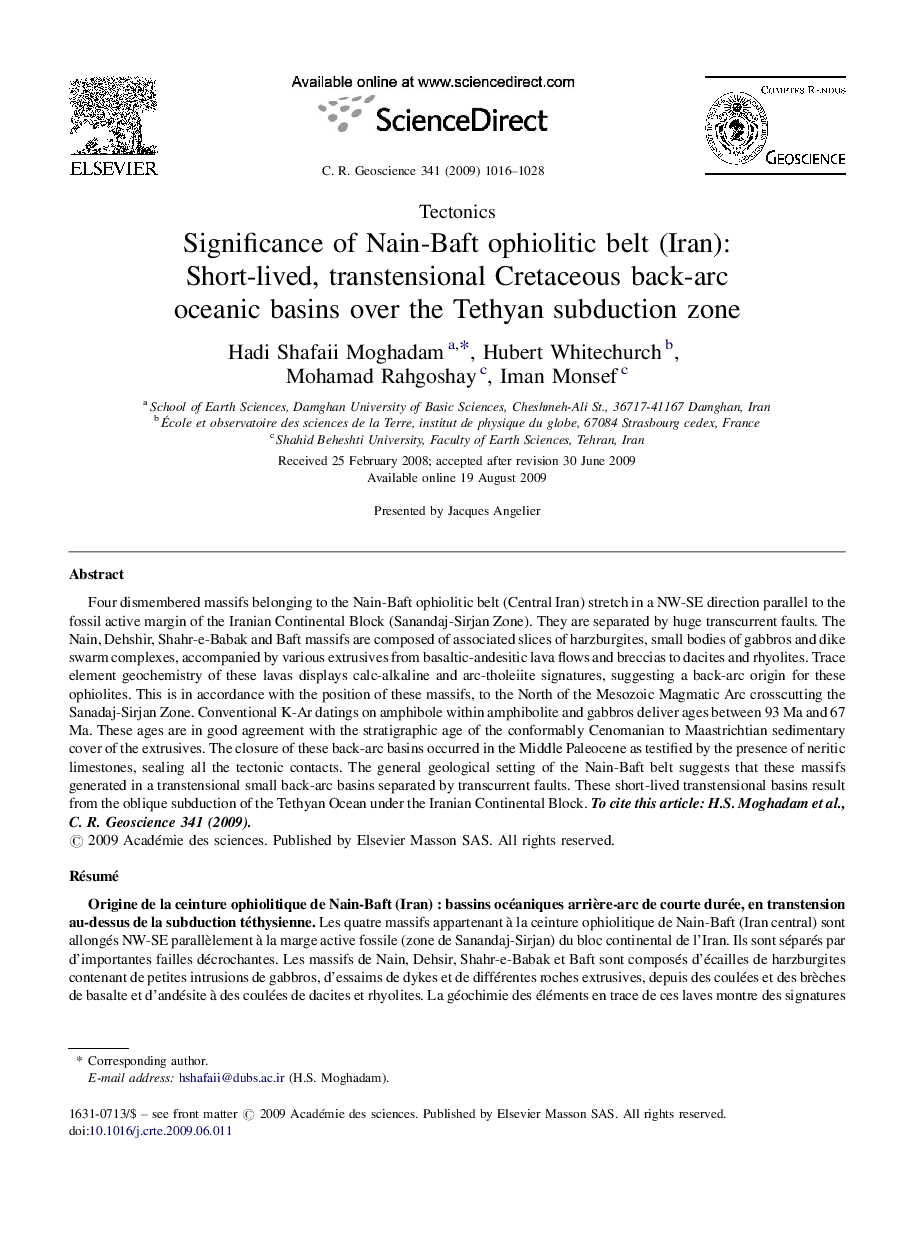| کد مقاله | کد نشریه | سال انتشار | مقاله انگلیسی | نسخه تمام متن |
|---|---|---|---|---|
| 4462580 | 1313509 | 2009 | 13 صفحه PDF | دانلود رایگان |

Four dismembered massifs belonging to the Nain-Baft ophiolitic belt (Central Iran) stretch in a NW-SE direction parallel to the fossil active margin of the Iranian Continental Block (Sanandaj-Sirjan Zone). They are separated by huge transcurrent faults. The Nain, Dehshir, Shahr-e-Babak and Baft massifs are composed of associated slices of harzburgites, small bodies of gabbros and dike swarm complexes, accompanied by various extrusives from basaltic-andesitic lava flows and breccias to dacites and rhyolites. Trace element geochemistry of these lavas displays calc-alkaline and arc-tholeiite signatures, suggesting a back-arc origin for these ophiolites. This is in accordance with the position of these massifs, to the North of the Mesozoic Magmatic Arc crosscutting the Sanadaj-Sirjan Zone. Conventional K-Ar datings on amphibole within amphibolite and gabbros deliver ages between 93 Ma and 67 Ma. These ages are in good agreement with the stratigraphic age of the conformably Cenomanian to Maastrichtian sedimentary cover of the extrusives. The closure of these back-arc basins occurred in the Middle Paleocene as testified by the presence of neritic limestones, sealing all the tectonic contacts. The general geological setting of the Nain-Baft belt suggests that these massifs generated in a transtensional small back-arc basins separated by transcurrent faults. These short-lived transtensional basins result from the oblique subduction of the Tethyan Ocean under the Iranian Continental Block.
RésuméLes quatre massifs appartenant à la ceinture ophiolitique de Nain-Baft (Iran central) sont allongés NW-SE parallèlement à la marge active fossile (zone de Sanandaj-Sirjan) du bloc continental de l’Iran. Ils sont séparés par d’importantes failles décrochantes. Les massifs de Nain, Dehsir, Shahr-e-Babak et Baft sont composés d’écailles de harzburgites contenant de petites intrusions de gabbros, d’essaims de dykes et de différentes roches extrusives, depuis des coulées et des brèches de basalte et d’andésite à des coulées de dacites et rhyolites. La géochimie des éléments en trace de ces laves montre des signatures de tholeiites d’arc à calco-alcalines, suggérant une origine arrière-arc pour ces ophiolites. Cette affinité géochimique est en accord avec la position géologique de ces massifs, au nord de l’arc mésozoïque recoupant la zone de Sanandaj-Sirjan. Les datations K-Ar conventionnelles sur amphibole dans des gabbros et une amphibolite ont fourni des âges de 93 à 67 Ma (Cénomanien-Maastritchien). Ces âges sont compatibles avec l’âge stratigraphique des sédiments recouvrant les laves. La fermeture de ces bassins est datée du Paléocene moyen, comme en témoigne la présence de calcaires néritiques, scellant les contacts. La position géologique générale des massifs de la ceinture de Nain-Baft suggère que ces ophiolites se sont formées dans des bassins arrière-arc de courte durée de vie, en transtension le long de failles transcurrentes, au-dessus d’une zone de subduction oblique de l’océan téthysien sous le continent iranien.
Journal: Comptes Rendus Geoscience - Volume 341, Issue 12, December 2009, Pages 1016–1028